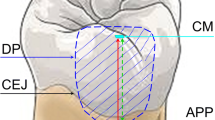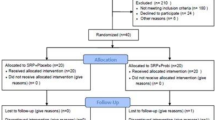Abstract
Objectives
To investigate the effect of various dilutions of antibiotic medicaments used in endodontic regeneration on the survival of human dental pulp stem cells (DPSCs) and to determine their antibacterial effect against established Enterococcus faecalis biofilm.
Materials and methods
The cytotoxic and antibacterial effects of different triple (TAP) and double antibiotic paste (DAP) dilutions (0.125, 0.25, 0.5, 1, and 10 mg/ml) were tested against Enterococcus faecalis established biofilm and DPSC. Established bacterial biofilm were exposed to antibiotic dilutions for 3 days. Then, biofilms were collected, spiral plated, and the numbers of bacterial colony forming units (CFU/ml) were determined. For the cytotoxic effect, lactate dehydrogenase activity assays (LDH) and cell viability assays (WST-1) were used to measure the percentage of DPSC cytotoxicity after 3-day treatment with the same antibiotic dilutions. A general linear mixed model was used for statistical analyses (α = 0.05).
Results
All antibiotic dilutions significantly decreased the bacterial CFU/ml. For WST-1 assays, all antibiotic dilutions except 0.125 mg/ml significantly reduced the viability of DPSC. For LDH assays, the three lowest tested concentrations of DAP (0.5, 0.25, 0.125 mg/ml) and the two lowest concentrations of TAP (0.25 and 0.125 mg/ml) were non-toxic to DPSC.
Conclusions
All tested dilutions had an antibacterial effect against E. faecalis. However, 0.125 mg/ml of DAP and TAP showed a significant antibacterial effect with no cytotoxic effects on DPSCs.
Clinical relevance
Using appropriate antibiotic concentrations of intracanal medicament during endodontic regeneration procedures is critical to disinfect root canal and decrease the adverse effects on stem cells.




Similar content being viewed by others
References
Nosrat A, Seifi A, Asgary S (2011) Regenerative endodontic treatment (revascularization) for necrotic immature permanent molars: a review and report of two cases with a new biomaterial. J Endod 37:562–567
Thibodeau B, Trope M (2007) Pulp revascularization of a necrotic infected immature permanent tooth: case report and review of the literature. Pediatr Dent 29:47–50
Lenzi R, Trope M (2012) Revitalization procedures in two traumatized incisors with different biological outcomes. J Endod 38:411–414
Murray PE, Garcia-Godoy F, Hargreaves KM (2007) Regenerative endodontics: a review of current status and a call for action. J Endod 33:377–390
Lovelace TW, Henry MA, Hargreaves KM, Diogenes A (2011) Evaluation of the delivery of mesenchymal stem cells into the root canal space of necrotic immature teeth after clinical regenerative endodontic procedure. J Endod 37:133–138
Hoshino E, Kurihara-Ando N, Sato I, Uematsu H, Sato M, Kota K et al (1996) In-vitro antibacterial susceptibility of bacteria taken from infected root dentine to a mixture of ciprofloxacin, metronidazole and minocycline. Int Endod J 29:125–130
Sato I, Ando-Kurihara N, Kota K, Iwaku M, Hoshino E (1996) Sterilization of infected root-canal dentine by topical application of a mixture of ciprofloxacin, metronidazole and minocycline in situ. Int Endod J 29:118–124
Miller EK, Lee JY, Tawil PZ, Teixeira FB, Vann WF (2012) Emerging therapies for the management of traumatized immature permanent incisors. Pediatr Dent 34:66–69
Garcia-Godoy F, Murray PE (2012) Recommendations for using regenerative endodontic procedures in permanent immature traumatized teeth. Dent Traumatol 28:33–41
Diogenes A, Henry MA, Teixeira FB, Hargreaves KM (2013) An update on clinical regenerative endodontics. Endod Top 28:2–23
Trope M (2010) Treatment of the immature tooth with a non-vital pulp and apical periodontitis. Dent Clin N Am 54:313–324
Iwaya SI, Ikawa M, Kubota M (2001) Revascularization of an immature permanent tooth with apical periodontitis and sinus tract. Dent Traumatol 17:185–187
Ruparel NB, Teixeira FB, Ferraz CC, Diogenes A (2012) Direct effect of intracanal medicaments on survival of stem cells of the apical papilla. J Endod 38:1372–1375
Yadlapati M, Souza LC, Dorn S, Garlet GP, Letra A, Silva RM (2014) Deleterious effect of triple antibiotic paste on human periodontal ligament fibroblasts. Int Endod J 47:769–775
Labban N, Yassen GH, Windsor LJ, Platt JA (2014) The direct cytotoxic effects of medicaments used in endodontic regeneration on human dental pulp cells. Dent Traumatol 30:429–434
Srisuwan T, Phumpatrakom P (2014) Regenerative capacity of human dental pulp and apical papilla cells after treatment with a 3-antibiotic mixture. J Endod 40:399–405
Althumairy RI, Teixeira FB, Diogenes A (2014) Effect of dentin conditioning with intracanal medicaments on survival of stem cells of apical papilla. J Endod 40:521–525
Sabrah AH, Yassen GH, Gregory RL (2013) Effectiveness of antibiotic medicaments against biofilm formation of Enterococcus faecalis and Porphyromonas gingivalis. J Endod 39:1385–9138
Chavez de Paz LE (2007) Redefining the persistent infection in root canals: possible role of biofilm communities. J Endod 33:652–662
Stojicic S, Shen Y, Haapasalo M (2013) Effect of the source of biofilm bacteria, level of biofilm maturation, and type of disinfecting agent on the susceptibility of biofilm bacteria to antibacterial agents. J Endod 39:473–477
Perry BC, Zhou D, Wu X, Yang FC, Byers MA, Chu TM et al (2008) Collection, cryopreservation, and characterization of human dental pulp-derived mesenchymal stem cells for banking and clinical use. Tissue Eng C Methods 14:149–156
Woods EJ, Perry BC, Hockema JJ, Larson L, Zhou D, Goebel WS (2009) Optimized cryopreservation method for human dental pulp-derived stem cells and their tissues of origin for banking and clinical use. Cryobiology 59:150–157
Stuart CH, Schwartz SA, Beeson TJ, Owatz CB (2006) Enterococcus faecalis: its role in root canal treatment failure and current concepts in retreatment. J Endod 32:93–98
Kayaoglu G, Orstavik D (2004) Virulence factors of Enterococcus faecalis: relationship to endodontic disease. Crit Rev Oral Biol Med 15:308–320
Al-Ahmad A, Ameen H, Pelz K, Karygianni L, Wittmer A, Anderson AC et al (2014) Antibiotic resistance and capacity for biofilm formation of different bacteria isolated from endodontic infections associated with root-filled teeth. J Endod 40:223–230
Al-Ahmad A, Muller N, Wiedmann-Al-Ahmad M, Sava I, Hubner J, Follo M et al (2009) Endodontic and salivary isolates of Enterococcus faecalis integrate into biofilm from human salivary bacteria cultivated in vitro. J Endod 35:986–991
British Standards Institution (2006) Quantitative suspension test for the evaluation of basic bactericidal activity of chemical disinfectants and antiseptics: in test methods and requirments (phase 1). London, UK. EN 1040:2005
Arias-Moliz MT, Ferrer-Luque CM, Espigares-Garcia M, Baca P (2009) Enterococcus faecalis biofilms eradication by root canal irrigants. J Endod 35:711–714
Athanassiadis B, Abbott PV, George N, Walsh LJ (2010) An in vitro study of the antimicrobial activity of some endodontic medicaments against Enteroccus faecalis biofilms. Aust Dent J 55:150–155
Kishen A, Haapasalo M (2010) Biofilm models and methods of biofilm assessment. Endod Top 22:58–78
Barros J, Silva MG, Rocas IN, Goncalves LS, Alves FF, Lopes MA, Pina-Vaz I, Siqueira JF Jr (2014) Antibiofilm effects of endodontic sealers containing quaternary ammonium polyethylenimine nanoparticles. J Endod 40:1167–1171
George S, Kishen A (2007) Photophysical, photochemical, and photobiological characterization of methylene blue formulations for light-activated root canal disinfection. J Biomed Opt 12:034029
Kikkawa R, Yamamoto T, Fukushima T, Yamada H, Horii I (2005) Investigation of a hepatotoxicity screening system in primary cell cultures—“what biomarkers would need to be addressed to estimate toxicity in conventional and new approaches?”. J Toxicol Sci 30:61–72
Huhtala A, Mannerstrom M, Alajuuma P, Nurmi S, Toimela T, Tahti H et al (2002) Comparison of an immortalized human corneal epithelial cell line and rabbit corneal epithelial cell culture in cytotoxicity testing. J Ocul Pharmacol Ther 18:163–175
American Association of Endodontists (2014) AAE clinical considerations for a regenerative procedure. USA. https://www.aae.org/uploadedfiles/publications_and_research/research/currentregenerativeendodonticconsiderations.pdf. Accessed 5 Aug 2014
Nagata JY, Gomes BP, Rocha Lima TF, Murakami LS, de Faria DE, Campos GR et al (2014) Traumatized immature teeth treated with 2 protocols of pulp revascularization. J Endod 40:606–612
Becerra P, Ricucci D, Loghin S, Gibbs JL, Lin LM (2014) Histologic study of a human immature permanent premolar with chronic apical abscess after revascularization/revitalization. J Endod 40:133–139
Bottino MC, Kamocki K, Yassen GH, Platt JA, Vail MM, Ehrlich Y et al (2013) Bioactive nanofibrous scaffolds for regenerative endodontics. J Dent Res 92:963–969
Bottino MC, Yassen GH, Platt JA, Labban N, Windsor LJ, Spolnik KJ et al (2013) A novel three-dimensional scaffold for regenerative endodontics: materials and biological characterizations. J Tissue Eng Regen Med. doi:10.1002/term.1712
Conflict of interest
WSG is consulting medical director of Cook General BioTechnology, LLC. The other authors declare no potential conflicts of interest.
Author information
Authors and Affiliations
Corresponding author
Rights and permissions
About this article
Cite this article
Sabrah, A.H.A., Yassen, G.H., Liu, WC. et al. The effect of diluted triple and double antibiotic pastes on dental pulp stem cells and established Enterococcus faecalis biofilm. Clin Oral Invest 19, 2059–2066 (2015). https://doi.org/10.1007/s00784-015-1423-6
Received:
Accepted:
Published:
Issue Date:
DOI: https://doi.org/10.1007/s00784-015-1423-6




